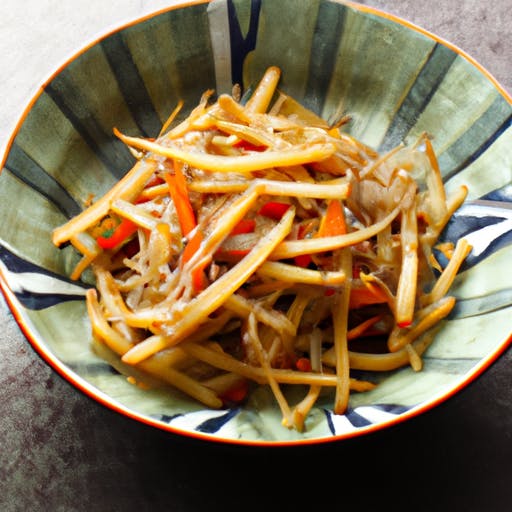
Ingredients:
Vegetables:
- 2 burdock roots (180 calories, $1.50)
- 1 carrot (50 calories, $0.50)
- 1 tablespoon vegetable oil (120 calories, $0.25)
Noodles:
- 8 ounces of soba noodles (400 calories, $1.50)
Sauce & Toppings:
- 2 tablespoons soy sauce (40 calories, $0.25)
- 1 tablespoon mirin (50 calories, $0.25)
- 1 tablespoon sesame oil (120 calories, $0.25)
- 1 tablespoon sesame seeds (150 calories, $0.50)
Total Calories: 1,110
Total Cost: $4.50
Total Cook Time: 30 minutes
Total Servings: 4
Instructions:
- Prepare the Burdock Root: Start by peeling the burdock roots with a vegetable peeler to remove the tough outer layer. Burdock root, also known as gobo in Japanese, has a distinctive earthy, slightly sweet flavor that is a staple in many Asian dishes. Once peeled, cut the burdock roots into thin matchstick-sized pieces. The key here is to slice them thinly so they can absorb the flavors of the sauce and cook evenly. As you cut the burdock, try to avoid any dark spots in the root, as they can make the dish bitter. After slicing, place the cut pieces in a bowl of water to prevent them from browning.
- Prepare the Carrot: Peel the carrot and cut it into matchstick-sized pieces as well. The carrot adds a pop of color and sweetness to the dish, creating a beautiful contrast with the slightly bitter burdock root. As with the burdock root, the goal is to cut the carrot into thin, uniform strips so that it cooks evenly and blends well with the other ingredients. Carrots are high in beta-carotene and provide a natural sweetness that balances the earthiness of the burdock root.
- Heat the Oil: Heat 1 tablespoon of vegetable oil in a large skillet or wok over medium heat. The oil serves as the base for cooking the vegetables, helping them to soften and absorb the flavors of the sauce. As the oil heats up, you’ll begin to smell a light, fragrant scent, signaling that it’s ready for the next step.
- Stir-Fry the Vegetables: Add the prepared burdock roots and carrots to the heated skillet. Stir them frequently to ensure they cook evenly and don’t burn. Stir-fry the vegetables for about 5 minutes until they begin to soften, but still retain some of their crispness. This step helps to release the natural flavors of the vegetables and allows them to absorb the oil, creating a rich base for the sauce. As you cook, you may notice the vegetables starting to shrink slightly as they soften, which is normal.
- Cook the Soba Noodles: While the vegetables are stir-frying, you can cook the soba noodles in a separate pot. Bring a large pot of water to a boil, and add the soba noodles. Cook according to the package instructions, usually around 4-5 minutes, until the noodles are tender but still firm to the bite. Once the noodles are cooked, drain them and set them aside. To prevent the noodles from sticking together, you can rinse them briefly under cold water. Soba noodles are made from buckwheat flour, giving them a nutty, slightly earthy flavor that pairs wonderfully with the burdock root stir-fry.
- Prepare the Sauce: In a small bowl, mix together the soy sauce, mirin, and sesame oil. This trio of ingredients forms the flavorful base of the sauce that will coat the vegetables and noodles. Soy sauce provides a savory umami flavor, mirin adds a touch of sweetness and depth, while sesame oil contributes a rich, nutty aroma that enhances the overall taste. Stir the ingredients together to ensure they are well combined. The mirin’s sweetness balances out the saltiness of the soy sauce, creating a harmonious sauce that will perfectly complement the earthy burdock root.
- Combine the Sauce with the Vegetables: Pour the sauce mixture over the stir-fried burdock root and carrots. Stir well to ensure that all of the vegetables are coated with the sauce. As the sauce hits the hot vegetables, it will begin to bubble slightly, and the vegetables will absorb its flavors. Let the mixture cook for another 3-4 minutes, stirring occasionally, until the vegetables are tender but still have a slight crunch. You want the vegetables to retain some bite for texture, so be careful not to overcook them. The sauce should thicken slightly and become glossy, adhering beautifully to the vegetables.
- Add the Soba Noodles: Once the burdock root and carrots are tender and the sauce has thickened, it’s time to add the cooked soba noodles. Gently toss the noodles into the skillet, making sure that they are well coated in the sauce and vegetables. Stir carefully to avoid breaking the delicate soba noodles. This step is crucial because it ensures the noodles soak up the flavors of the sauce, giving them a rich, savory taste. The combination of the chewy noodles, earthy burdock root, and sweet carrots creates a satisfying, balanced dish.
- Garnish and Serve: Once everything is well combined, remove the skillet from the heat. Transfer the Kinpira Gobo to serving plates and sprinkle the sesame seeds on top for an added crunch and nutty flavor. The sesame seeds also enhance the visual appeal of the dish, adding a delicate crunch that contrasts beautifully with the soft noodles and vegetables. For an extra touch of color, you can also garnish with sliced green onions or a sprinkle of chili flakes if you prefer some heat.
- Enjoy: Serve your delicious Kinpira Gobo immediately while it’s hot. This dish is perfect as a light lunch or dinner, offering a satisfying combination of textures and flavors. The burdock root brings a unique, earthy taste, while the carrots provide sweetness and color, and the soba noodles offer a nutty chewiness. The savory sauce brings everything together, creating a dish that is both comforting and flavorful.
Additional Tips:
- Customize the Vegetables: While burdock root and carrot are the traditional vegetables in Kinpira Gobo, you can easily customize the recipe by adding other vegetables such as shiitake mushrooms, bell peppers, or even spinach. These vegetables will add variety and freshness to the dish.
- Adjust the Sauce: If you prefer a sweeter or saltier flavor, feel free to adjust the amount of mirin or soy sauce in the recipe. Adding more mirin will increase the sweetness, while extra soy sauce will bring more saltiness to the dish. You can also add a bit of sugar or honey if you like a stronger sweet note.
- Meal Prep: This dish is perfect for meal prep. It can be made ahead of time and stored in the refrigerator for a few days. The flavors will continue to meld and deepen as it sits, making it a great option for leftovers. To reheat, simply warm it in the microwave or on the stovetop, adding a little water if necessary to loosen the sauce.
- Add Protein: If you’d like to add protein to the dish, consider adding tofu, tempeh, or grilled chicken. These proteins will absorb the savory sauce and provide a more filling meal.
- Serve with Pickles: Kinpira Gobo pairs beautifully with Japanese pickles (tsukemono). The tangy, salty pickles offer a delightful contrast to the rich flavors of the stir-fry, adding balance to the dish.
Note:
Kinpira Gobo is a traditional Japanese dish that’s not only healthy but also incredibly versatile. It’s a great way to introduce burdock root, a vegetable that’s often underused in Western kitchens, into your meals. Packed with fiber, vitamins, and minerals, this dish provides a wholesome, delicious option that’s sure to impress your taste buds. Whether you enjoy it as a stand-alone meal or as a side dish, Kinpira Gobo is a flavorful and nourishing choice that celebrates the beauty of simple, seasonal ingredients.

